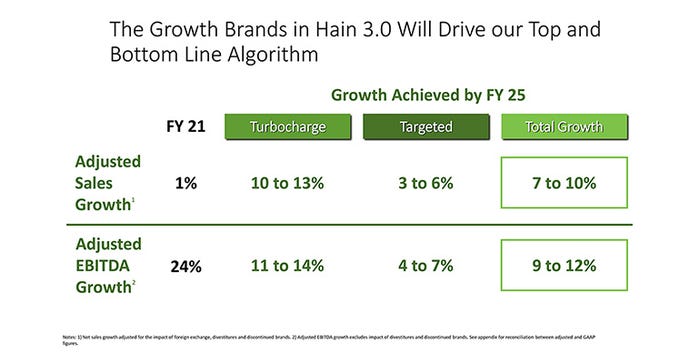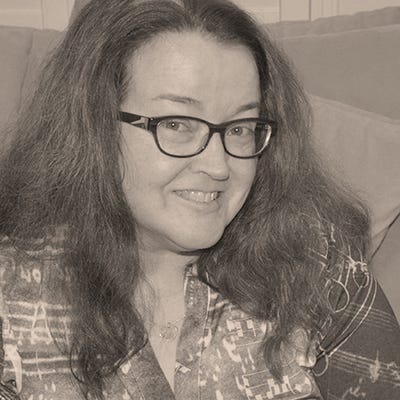Hain Celestial introduces next strategy to increase sales, profitsHain Celestial introduces next strategy to increase sales, profits
Health and wellness company reaches 'Hain 2.0' goals a year earlier than expected; executives present the next step virtually on Investor Day.

For Investor Day 2021, Hain Celestial CEO Mark Schiller detailed for the virtual audience how the company has met the goals he laid out in 2019, just months after he joined the company.
Most importantly, his plan moved Hain from being a holding company to being an operating company, he said Tuesday. And his team accomplished the goal one year earlier than promised.
"We've gone from a business that was declining in 2019 to one that had grown an average of 3% in the last two years—in line with our 3%-6% guidance that we said would reach at the end of F22," Schiller said. The fourth quarter ended June 30. In addition, EBITDA margins have exceeded expectations. The company planned to increase EBITDA margins to 13% in fiscal 2022 from 9% in fiscal 2019.
"We've already achieved 14% a year ahead of schedule, with more margin expansion expected this year," Schiller said.
Since Investor Day 2019, Hain Celestial has generated a cumulative shareholder return of 125%, he said, noting that is more than three times the consumer packaged goods companies' average. But Hain 2.0, as Schiller described the previous strategic plan, wasn't the end of the changes. He and other company executives presented on Tuesday Hain 3.0 to a virtual audience for Investor Day. This plan, which set goals for fiscal year 2025, is about making Hain Celestial a global health and wellness company with industry-leading growth, the CEO said.
"We've transformed our North America business into a strong operating company with a total of 14 leading-share brands and significant growth potential," Schiller said.

Next step: Focus on growth
In the Hain 3.0 era, the company will focus on creating industry-leading, top-line growth; expanding margins; and generating double-digit profit increases, Schiller said. He expects to see high single-digit growth in the second half of this fiscal year—at the beginning of calendar 2022, in other words.
The company again is segmenting its portfolio, this time into growth, fuel for growth and simplify categories. Within the growth category, products are classified as turbocharge growth or targeted investment. Chief Financial Officer Javier Idrovo explained the new segments.
Turbocharge Growth consists of the leading share brands in very high growth categories:
They accounted for 40% of the company's sales in fiscal 2021, up from 28% in fiscal 2019.
They generated 41% percent of Hain's profit this past year with margins in the high teens, compared with 37% in fiscal 2019.
In the Hain 3.0 era, they will grow to 50% of sales and 53% of the company's profit
Products in this category are plant-based meat, non-dairy milk and snacks.
Targeted Investment products are the leading share brands in lower-growth categories:
These brands generated 33% of Hain's total sales in fiscal 2021, compared with 28% in fiscal 2019.
They accounted for 37% of profits, with margins in the high teens, compared with 42% in fiscal 2019.
Under the Hain 3.0 plan, these products will account for 34% of sales and 34% of EBITDA.
Products include tea, baby, yogurt and personal care.
Fuel for growth are stable brands, such as premium pantry brands:
They accounted for 19% of sales in fiscal 2021, compared with 18% in fiscal 2019.
They generated 16% of Hain's profit last year, compared with 19% in fiscal 2019.
During the Hain 3.0 plan, they will account for 16% of sales and 13% of profit.
Simplify category products are those whose sales and profits are declining:
In fiscal 2021, they accounted for 8% of sales, compared with 7% in fiscal 2019.
Hain did not project sales or profit goals in this category under the new plan. They will be managed for profit and eventually divested.
Eventually, Schiller said, Hain Celestial will divest its personal care businesses to become a food-only company. Personal care has significant growth opportunities, however, so Hain will continue to invest and create shareholder value in that category until those brands are sold, he said.
Top-line growth opportunities
During the Hain 2.0 phase, the company created new products that led to expanded distribution and bringing in new customers. With its popular Veggie Straws snack, Hain developed new flavors, including Screamin' Hot, which attracted young men to the healthy snacks arena. The company also took advantage of the "puffs" food trend and introduced a line of Veggie Puffs, as well as a children's product that features Sesame Street characters on the packaging and in marketing materials.
To meet consumers where they are, so to speak, Hain also created different sized packaging for its Veggie snacks, offering multi-packs and smaller bags for today's smaller families. These changes increased household penetration, an increase in repeat buyers and even higher profits, Schiller said.
Three hundred projects valued at approximately $100 million already are in the pipeline for fiscal years 2022 and 2023, reported David Karch, executive vice president and chief transformation officer.
Schiller told investors, "We believe it's a pretty exciting strategy and algorithm, and one that we are confident will deliver industry-leading returns for our shareholders."
About the Author
You May Also Like





